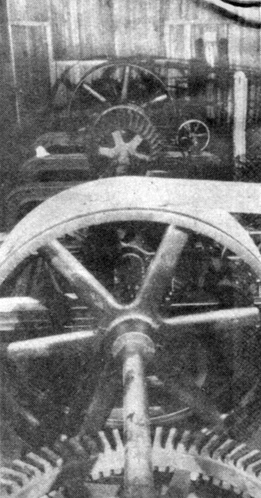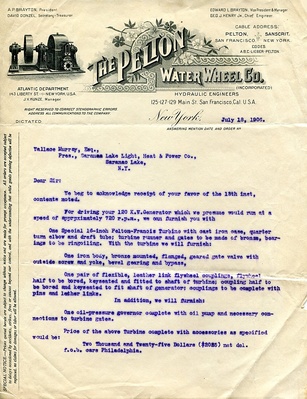 Water powered wheel at the Saranac Lake Electric Company.
Water powered wheel at the Saranac Lake Electric Company.
Adirondack Daily Enterprise, October 31, 1986 Adirondack Daily Enterprise, October 31, 1986
Electric history of Saranac Lake
On September 20th, 1894 the Saranac Lake Electric Company, was formed by Orlando Blood, Wallace Murray, and Orville Morse. Blood was president and Murray as treasurer. The dam and sawmill that Capt. Pliny Miller had built in 1827 were later sold to Steve Merchant who operated the sawmill for many years prior to selling out to Branch and Callanan.
On the above date in 1894 Branch and Callanan sold the mill together with riparian rights to Orlando Blood for $5,500.00. The Blood-Murray-Morse group had new plans for the old mill.
The Village of Saranac Lake was incorporated in 1892 but still had no electric service, and they planned to do something about it. The timber built mill was soon replaced with a more substantial brick structure to house the electric generators. Head gates were installed at the Main Street bridge with a penstock running under the street to carry the water to the two James Lefell water wheels beneath the plant.
A pair of Stanley dynamos were belt driven on the floor above the water chest. Among those who formed the work force during construction were such early village residents as: W. Betters, J. Cronk, J. Marquay, E. Dobbins, G. Lashway, E. Tromblee, R. Moody, J. Robbins, G. West, and H. Eicholz.
Lines strung
 An estimate for a new turbine for the Saranac Lake Light, Heat & Power Company's electric plant, dated 1906
An estimate for a new turbine for the Saranac Lake Light, Heat & Power Company's electric plant, dated 1906
C.E. Pinelle was hired to furnish the technical expertise and was made company manager of the fledgling enterprise. As soon as the hydro plant was ready to generate some lines were strung into the village towards potential customers. To give an example of the "high" construction costs of that era two hundred crossarms were purchased from Branch and Callanan on May 3rd, 1895 at the exorbitant price of ten cents each.
Apparently there was no dearth of willing recipients as the residents lined up to take service. Among the very first to hook into the system were: the Riverside Inn, the village office, Aaron Goldsmith, the Potter Co., J. H. Farrington, Fowler's Livery, Walton & Starks,1Milo B. Miller, the Harrietstown Town Hall, K. Blumenthal, T. Latour, C. Greenough, M.A. Leonard, J. Hogan, W. Rice, G. Grice, and, of course, the medical fraternity of Drs. Trudeau 2, Kendall, Baldwin, and Wicker.
It is safe to assume that the first lights were turned on in the electric plant itself, and, since both Blood and Murray were proprietors of the Riverside Inn, it could well have been number two. As the number of customers multiplied, even at this early date, overload-problems arose. The converters of 1895 were rated in capacity by the number of lamps each device could carry. Apparently Blood and Murray, being interested in profit, were willing to disregard these limits in an effort to increase their business. Manager C.E. Pinelle did not approve of this type of operation and cited many cases where converters were badly overloaded.
Resignation
On Dec. 25th, 1895 he warned the owners that they were courting trouble and promptly wrote a letter of resignation. He was replaced by Perley Gould on June 1st, 1896. The company title was changed to the Saranac Lake Electric Light Co. with Blood as president and Gould as Treasurer. Two years later the corporation again changed its structure and became the Saranac Lake Light, Heat, and Power Co. with Wallace Murray as president. On August 4th, 1904 he purchased the John H. Farrington lot for $300.00 to close the property line across the bridge from the power plant and adjacent to the head gates. Meanwhile another electric utility was being born on the shore of St. Regis Lake in 1905 when Paul Smith and his two sons formed the Paul Smiths Electric Light & Power Company. Their prospects were located further downstream at Franklin Falls and Union Falls with a much greater generating capacity than the 290KW at Saranac Lake.
It would be entirely too speculative to assume which party made the first move, but on January 16th, 1907 Wal Murray sold out to Paul Smith for $125,000. Perhaps he saw the handwriting on the wall or perhaps Paul Smith saw a major market in the fast growing village. In either case the Saranac Lake Light, Heat & Power Co. became a part of the Paul Smith system. Transmission lines carrying 22,000 volts were being constructed from Franklin Falls to Bloomingdale and thence to Saranac Lake. In 1912 the first generator at Franklin Falls went on the line assuring adequate power to this area. Paul Smith did not live long enough to enjoy the full fruits of his plans. He died in Montreal on Dec. 15th of that same year.
Gould in charge
The little plant at Saranac Lake continued to operate under the supervision of Perley Gould while Phelps Smith, Paul's oldest son, became president of the parent company. Wal Murray rented office space to the company in the Spaulding Block, a brick building located across River Street from the Riverside Inn, which he had acquired from Orlando Blood.
After twenty years in these quarters Phelps decided to build his own office building. In 1927 the new Paul Smith's Office Building was erected directly astride the old flume which ran beneath the new building to connect with the hydro plant in the old brick structure at the rear. The office building was handsomely constructed of steel and stone to a height of 3 stories complete with an electric elevator.
Although Phelps was proud of the new edifice, he continued to spend most of his time at the hotel headquarters. From this office he managed not only the power company, but the hotel company, the telephone company, and an electric railroad that ran from Lake Clear to the hotel all bearing the Paul Smith banner. He had private telephone lines connecting Paul Smith's with the plants at Saranac Lake, Franklin Falls, Union Falls, and all the switching stations of the system.
Iron hand
He was the major domo of his little empire, and he ruled with an iron hand. Phelps was noted for his hot temper and was known to fire a man in the morning and hire him back in the afternoon. When he chose to chew out one of his plant operators, via the private phone, the line would suddenly go dead. Allowing time for Phelps to cool down, and the line to "clear," the operator would call back to explain that a fuse had blown. It didn't always work.
Phelps Smith died in 1937 and since two younger brothers, Henry and Paul Jr., had predeceased him it was the end of the Smith dynasty. He was not only the last of the Smiths but also the last of the so-called rugged individuals. For years he had plagued the Public Service Commission with his operating procedures and his accounting methods. An employee could work for the hotel company, the telephone company, and the electric company all in the same day. Whenever an agent from the P.S.C. came to investigate, Phelps would wine and dine him sending him back to Albany happy but with no concessions.
New commander
Richard J. Longtin, a long-time employee and second in command to Phelps took over as president of all the companies. He also preferred to operate out of the Paul Smith's office and came to Saranac Lake only to sign the payroll or keep important appointments. In 1938 many changes took place in and around No. 2 Main Street. Perley Gould was retired from the company and was replaced by Raleigh H. Finch, an electrical engineer from Pennsylvania, who had been doing contract work in the electric plants. The old Riverside Inn was torn down and a new concrete dam was built by the village with W.P.A. funds. The Paul Smith's company donated $10,000 toward the cost of the new dam which was fastened to the east wall of the office building.
The two Stanley generators continued to hum in the old hydro plant but were no longer considered to be an important factor in the total generation output. When World War II came along, Longtin and Finch decided to scrap the old machinery and the metals went to the war effort drive.
Sold to Niagara Mohawk
In 1966 the Paul Smith's Electric Light and Power and Railroad Company was sold to the Niagara Mohawk Power Corporation. The new owners made use of the office building at 2 Main Street until a new service center was built on Lake Colby Drive and eventually the commercial office was relocated to this location. Now both the old hydro plant and the office building stand forlornly vacant thus ending a 140-year phase of local history. Pliny Miller, Orlando Blood, and Wal Murray are long gone and the reign of the Smiths have passed.
Footnotes
1. See Walton and Tousley Hardware
2. Certainly for use at the Saranac Laboratory, if not at his own house.



